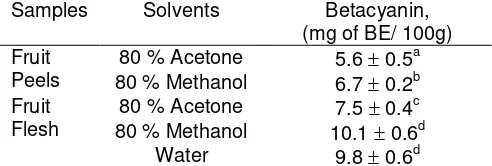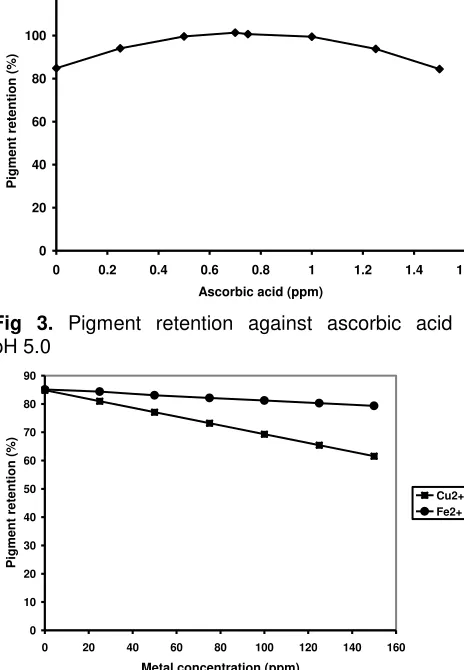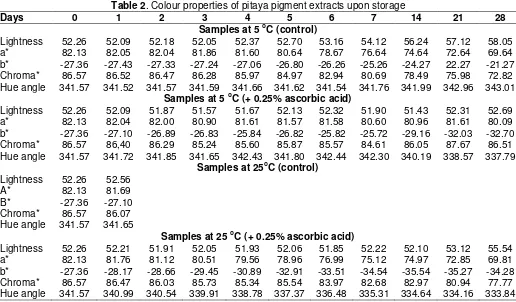Tang, C.S. & Norziah, M.H.
* Corresponding author. Tel: 04-6532222/Fax : 04-6573678 Email address : norziah@usm.my
STABILITY OF BETACYANIN PIGMENTS
FROM RED PURPLE PITAYA FRUIT (
Hylocereus polyrhizus
) :
INFLUENCE OF PH, TEMPERATURE, METAL IONS AND ASCORBIC ACID
Tang, C.S and Norziah M.H*
School of Industrial Technology, Food Technology Division, Universiti Sains Malaysia, 11800 Penang, Malaysia.
Received 30 May 2007; Accepted 30 July 2007
ABSTRACT
Betacyanin pigments from red-purple pitaya fruit (Hylocereus polyrhizus) could be an attractive source of red colourant for food application. This paper presents results on the extraction of betacyanin pigments from pitaya fruits grown locally in Malaysia. Both the flesh of the fruit and its mesocarp were investigated and it was found that the flesh had higher pigment contents compared to its peel component. The concentration of betacyanins expressed as betanin equivalents per 100 g of flesh and peel were 10.1 0.6 mg and 6.7 0.2 mg, respectively when 80% methanol was used. The stability of betacyanin pigments were investigated at different pH, temperature and in presence of different concentrations of metal ions (Cu2+ and Fe2+) and ascorbic acid. The results showed that the pigment was most stable at pH range between 5 and 6. However, it forfeited its stability to the heat induced at elevated temperatures. Metal ions (Cu2+ and Fe2+) proved to be capable of accelerating betacyanin degradation, with Cu2+ exhibiting the greatest effect. By contrast, supplementation with ascorbic acid could enhance the pigment stability against the detrimental effects caused by pH, temperature and metal ions. Nevertheless, if the concentration of ascorbic acid exceeds 0.7 %, it may change its role from pigment stabilizer to become a pro-oxidant.
Keywords: Betacyanin, pigments, pitaya fruit, Hylocereus polyrhizus, ascorbic acid
INTRODUCTION
Natural colourants from plant sources are receiving growing interest from both food manufacturers and consumers in the continuing replacement of synthetic dyes [1,2]. However, replacing synthetic dyes with natural colorants offers a challenge because the colour and stability of plant pigments are dependent on several factors, including structure and concentration of the pigment, pH, temperature, light intensity, presence of, metallic ions, enzymes, oxygen, ascorbic acid, sugars and their degradation products, among others [3]. Identifying stable aqueous colorant extracts (e.g. fruit and vegetable juices) is attractive because their GRAS (Generally Recognized As Safe) status makes them easily commercialized.
The fruits of Hylocereus species, known as red
pitaya or pitahaya, which means “the scaly fruit”, in Latin
America, belong to the cacti family which is native to the tropical forest regions of Mexico and Central and South America. In cacti, the most important fruit pigments are the red-violet betacyanins and the yellow betaxanthins which belong to the betalain pigments [4]. Producing a deep purple-coloured flesh comparable to red beet [5] or amaranth [6], betacyanins from purple pitaya (H. polyrhizus) has recently attracted interest as a potential alternative for red- beet. In the present study, betacyanin from purple pitaya (H. polyrhizus) was extracted using several solvents. However, the lower stability of natural plant pigments against environmental
factors could pose restriction to their utilization in industry. Therefore, an attempt was made in this study to assess the stability of the pigments under the influence of pH, temperature, metal ions (Cu2+ and Fe2+) and with supplementation of ascorbic acid, which may act as stabilizers.
EXPERIMENTAL SECTION
Fruit samples
Fresh purple-red pitaya fruits (H. polyrhizus) used in this study was obtained from a fruit plantation in Johore, Malaysia. Upon arrival of fruits, they were washed and peeled to remove the skins. The fruit flesh was macerated in a Waring blender until completely homogenized and kept in plastic containers wrapped in aluminium foil and stored at -20 oC prior to analysis. The peel parts were also stored under the same conditions as fruit flesh.
Solvents and reagents
Reagents and solvents of analytical or HPLC grade were obtained from Sigma-Aldrich, Merck or J.T. Baker.
Procedure
Pigment Extraction with several solvents
Tang, C.S. & Norziah, M.H.
give the highest extraction yield. The homogenized fruit flesh or peel was thawed prior to extraction. For pigment extraction from fruit flesh, solvents used were 80 % acetone, 80 % methanol and water. However, for peel component, only 80 % acetone and 80 % methanol were used for pigment extraction. During pigment extraction, 1 part of the sample (fruit flesh or peel) was shaken with 2 parts of solvent for a few minutes. It was allowed to stand for 15 min. Then, the seeds, raw fibres, mesocarp fibres and mucilagenous material were separated from the pigment extract by centrifugation at 3500 rpm for 15 min and filtration. The residue was re-extracted with the selected solvents in the same manner. The filtrate was combined with that obtained earlier and stored at -20 0C prior to betacyanin pigments quantification.
Quantitation of betacyanins
Red pitaya pigment content was measured in a similar way to that described by Cai et al [6], with slight modification. Quantification of betacyanins was carried out applying the equation Bc = [(A x DF x MW x 1000 / x l)] where Bc is the betanin equivalents in mg/L, A is the absorption value at the absorption maximum (max = 536
nm), DF is the dilution factor, MW is the molecular weight of betanin (550 g/mol), is the molar extinction coefficient of betanin (60,000 l/mol x cm), and l the pathlength of the cuvette. All determinations were performed in triplicate.
Pigment stability studies
Based on the yield of betacyanin content, water was selected as solvent for pigment extraction for the stability studies. The stability of betacyanin aqueous-based pitaya fruit extracts was evaluated under different pH under the experimental conditions described above. Pigment retention (%) was calculated by the formula [betacyanin content after storage time interval / betacyanin content at zero storage time] x 100. The effects of pH, metal ions and ascorbic acid on pigment retention were studied at 25 oC with sample inside capped vials covered with aluminium foil and sealed with parafilm. For the effects of temperature studies, test samples at pH 5.0 were immersed in a water bath and kept at various temperatures (25, 30, 35, 40, 45, 50, 55, 60, 65, 70, 75 oC) for 12 h. The test samples (10 mL) were prevented from the exposure of light and atmosphere as both factors could cause additional negative effects to the pigments. Triplicate measurements will be carried out.
Effects of supplementation with ascorbic acid
Betacyanin pigment stability improvement by supplementation of ascorbic acid at 0.23 % (w/w) concentration was evaluated at different temperatures (5 and 25 oC) over a storage period of 28 days. The pigment extracts were checked at several time intervals for pigment retention (%), color (lightness*, a*, b*, chroma and hue angleo) and color retention. All analyses for colour stability and chromaticity were done in duplicate.
Colour analyses
Color was measured by colorimeter (CM 3500D) obtained from Minolta Co., Japan. Results were given
on Commission Internationale de l’Eclairage L*, a*, and
b* (CIELAB) colour space coordinates. Hue angle [Ho = tan -1 b*/ a*) ] and Chroma [C* = (a*2 + b*2)1/2] were
Total betacyanin content in pigment extracts
Total betacyanin pigments were calculated and tabulated in Table 1. For both peel and flesh components, the yield obtained using methanol 80 % as solvent was significantly (p< 0.05) higher than with acetone. However, there was no significant differences of the yield obtained using methanol 80 % and water in extracting the desired pigments from fruit flesh. The concentration of betacyanins expressed as betanin equivalents per 100 g of flesh and peel were 10.1 0.6 mg and 6.7 0.2 mg, respectively when methanol 80% was used as solvent. The pigments contents in flesh agreed well with the values (10.3 0.22 mg) reported by Wu et al for pitaya fruits (H. polyrhizus) cultivated in Taiwan [8], but were much lower than the values (28 1.9 mg) reported by Wybraniec and Mizrahi for fruits grown in Israel [9].
Table 1. Concentration of betacyanin pigments
compounds using different solvents for extraction Samples Solvents Betacyanin,
(mg of BE/ 100g)
Tang, C.S. & Norziah, M.H.
Fig 2. Pigment retention (%) against temperature pH 5.0
The fruits cultivated in Malaysia were more similar with that grown in Taiwan. However, the pigment contents in peel component was lower than the results (13.8 0.85 mg) reported by Wu et al [8] who found that the peel exhibited higher pigments contents compared to flesh components.
Effects of pH, temperature, and metal ions on betacyanin pigment retention
For determination of betacyanin stability, overall % pigment retention was assesed. The results of pigment stability of fruit extracts from H. polyrhizus under the influence of different pH, temperature, ascorbic acid and metal ions (Cu2+ and Fe2+) are given in Fig 1, 2, 3 & 4, respectively. Analysis showed that betacyanin pigment was most stable at pH range between 5 and 6. Upon increasing the temperature from 25 to 75 oC pigment retention decreased with about 86% reduction at temperature of 75 oC. Maximum pigment stability was obtained for pitaya pigment preparations at pH 5.0 with ascorbic acid supplementation up to 0.7% affording a
0 temperature. Nevertheless, if the concentration of ascorbic acid exceeded 0.7 %, it may change its role from pigment stabilizer to become a pro-oxidant. The effects of metal ions (Fig 4) on betacyanin degradation was enhanced with Cu 2+ exhibiting the greatest effect.
Betacyanin pigment stabilisation by addition of ascorbic acid
Tang, C.S. & Norziah, M.H. 0
20 40 60 80 100 120
0 2 4 6 8 10 12 14 16 18 20 22 24 26 28
No of days
Pigment retention (%)
5 deg C (control) 5 deg C (+ 0.25% Vit C)
25 deg C (control) 25 deg C (+ 0.25% Vit C)
Fig 5. Pigment retention upon storage days
0 20 40 60 80 100 120
0 2 4 6 8 10 12 14 16 18 20 22 24 26 28 No of days
Colour rete
ntion (%)
5 deg C (control) 5 deg C (+0.25% Vit C)
25 deg C (control) 25 deg C (+ 0.25% Vit C)
Fig 6. Colour retention upon storage days
Table 2. Colour properties of pitaya pigment extracts upon storage
Days 0 1 2 3 4 5 6 7 14 21 28
Samples at 5 oC (control)
Lightness 52.26 52.09 52.18 52.05 52.37 52.70 53.16 54.12 56.24 57.12 58.05 a* 82.13 82.05 82.04 81.86 81.60 80.64 78.67 76.64 74.64 72.64 69.64 b* -27.36 -27.43 -27.33 -27.24 -27.06 -26.80 -26.26 -25.26 -24.27 22.27 -21.27 Chroma* 86.57 86.52 86.47 86.28 85.97 84.97 82.94 80.69 78.49 75.98 72.82 Hue angle 341.57 341.52 341.57 341.59 341.66 341.62 341.54 341.76 341.99 342.96 343.01
Samples at 5 oC (+ 0.25% ascorbic acid)
Lightness 52.26 52.09 51.87 51.57 51.67 52.13 52.32 51.90 51.43 52.31 52.69 a* 82.13 82.04 82.00 80.90 81.61 81.57 81.58 80.60 80.96 81.61 80.09 b* -27.36 -27.10 -26.89 -26.83 -25.84 -26.82 -25.82 -25.72 -29.16 -32.03 -32.70 Chroma* 86.57 86,40 86.29 85.24 85.60 85.87 85.57 84.61 86.05 87.67 86.51 Hue angle 341.57 341.72 341.85 341.65 342.43 341.80 342.44 342.30 340.19 338.57 337.79
Samples at 25oC (control)
Lightness 52.26 52.56
A* 82.13 81.69
B* -27.36 -27.10 Chroma* 86.57 86.07 Hue angle 341.57 341.65
Samples at 25 oC (+ 0.25% ascorbic acid)
Lightness 52.26 52.21 51.91 52.05 51.93 52.06 51.85 52.22 52.10 53.12 55.54 a* 82.13 81.76 81.12 80.51 79.56 78.96 76.99 75.12 74.97 72.85 69.81 b* -27.36 -28.17 -28.66 -29.45 -30.89 -32.91 -33.51 -34.54 -35.54 -35.27 -34.28 Chroma* 86.57 86.47 86.03 85.73 85.34 85.54 83.97 82.68 82.97 80.94 77.77 Hue angle 341.57 340.99 340.54 339.91 338.78 337.37 336.48 335.31 334.64 334.16 333.84
thus measurements could not be made. Supplementation with ascorbic acid increased storage stability at 5 oC (91.6%) than at 25 oC (70.9%). Samples at 5 oC with addition of ascorbic acid did not show a decrease in pigment content for about 2 weeks compared to samples with ascorbic acid which showed a small reduction in pigment retention after about 5 days. This indicated that there is a stabilising effect of ascorbic acid on pigment retention. Fig 6 and Table 2 give results on the colour properties of pigment preparations. Greater colour retention at both temperatures in samples with ascorbic acid compared to samples without ascorbic
acid was found throughtout (Fig 6). Addition of ascorbic acid was able to retard lightness increment in both samples at both temperatures as shown in Table 2. A decreasing C* values was observed in samples at 25
o
Tang, C.S. & Norziah, M.H.
CONCLUSION
Red-purple pitaya extract was shown to display surprising pigment stability and nearly unaffected colour shade upon moderate thermal treatment. Since its pigments were previously shown to retain their appearance over a broad pH range (pH 3–7), application of purple pitaya as a natural food colorant appears to be promising.
REFFERENCES
1. Stintzing, F.C., and Carle, R., 2004, Trends Food Sci. & Techn., 15, 19-38.
2. Francis, F., 1989, Critical Rev. Food Sci. & Nutrition, 28, 273–314.
3. Mazza, G., and Miniati, E., 1993, Introduction. In Anthocyanins in fruits, vegetables, and grains (pp. 1–28). Boca Raton, FL: CRC Press (Chapter 1). 4. Wybraniec, S., Platzner, I., Geresh, S., Gottlieb, H.
E., Haimberg, M., and Mogilnitzki, M., 2001, Phytochem., 58, 1209–1212.
5. Stintzing, F.C., Schieber, A., and Carle, R., 2001, Eur. Food Res. & Techn., 212(4), 396–407.
6. Cai, Y., Sun, M., and Corke, H., 1998, J. Agric. & Food Chem., 46(11), 4491–4495.
7. Cai, Y.Z., and Corke, H., 1999, J. Food Sci., 64, 869–873.
8. Wu A.F., 2006, Food Chem., 95, 319-327.


